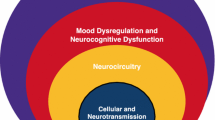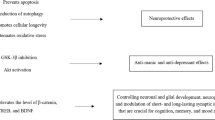Abstract
Investigations of the biochemical actions of lithium have identified many individual reactions that are affected, especially within cellular signaling systems, but the actions of lithium at different sites often appear opposing and difficult to integrate into a general mechanism of action. A bimodal mechanism of action of lithium is proposed which is in accord with many of the apparently contradictory results that have been published. This model describes the critical effect of lithium as that of a stabilizer of the magnitude of fluctuations of signaling processes. This is achieved by lithium balancing positive and negative regulators of signaling processes which results in lithium raising basal activities and diminishing maximal activities, thereby stabilizing signaling activities within an optimal range and preventing fluctuations either above or below this optimum. This model is shown to be applicable to many published results concerning the activation of AP-1 DNA binding and cyclic AMP production. Diverse sites of action of lithium are proposed to ultimately converge on the regulation of gene expression to contribute to mood stabilization.
Similar content being viewed by others
Author information
Authors and Affiliations
Corresponding author
Rights and permissions
About this article
Cite this article
Jope, R. A bimodal model of the mechanism of action of lithium. Mol Psychiatry 4, 21–25 (1999). https://doi.org/10.1038/sj.mp.4000444
Received:
Accepted:
Published:
Issue Date:
DOI: https://doi.org/10.1038/sj.mp.4000444
- Springer Nature Limited
Keywords
This article is cited by
-
Translational evidence for lithium-induced brain plasticity and neuroprotection in the treatment of neuropsychiatric disorders
Translational Psychiatry (2021)
-
Differential effects of antidepressants escitalopram versus lithium on Gs alpha membrane relocalization
BMC Neuroscience (2015)
-
Lithium in the treatment of bipolar disorder: pharmacology and pharmacogenetics
Molecular Psychiatry (2015)
-
Trimethyltin can induce cell death in the entorhinal cortex of rat brain: a histological architecture and neuronal density evaluation of the neuroprotective role of lithium chloride
Comparative Clinical Pathology (2015)
-
Potential Mechanisms of Action of Lithium in Bipolar Disorder
CNS Drugs (2013)




